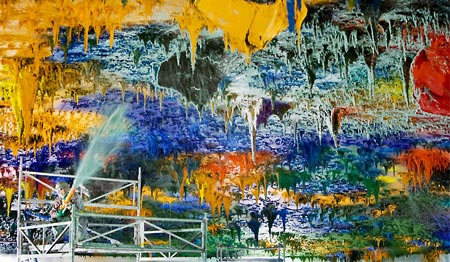Spanish Prime Minister José Luis Rodríguez Zapatero
has just unveiled Spain’s latest contribution to fostering
global peace and security. No, his government will not be sending more troops to
help rebuild Afghanistan.
And no, Spain will not be providing
more vaccines to help needy children in Africa.
Instead, the Zapatero government is the proud sponsor of a lavish decorative ceiling
at the
European headquarters of the United Nations in Geneva.
Miquel Barceló, one of the
world’s most highly paid abstract artists, was commissioned by Spain to
redecorate “Room XX” and its ellipsoidal dome at the Palais des Nations. He used more than 100 tons of paint to turn the
negotiating room into a cave dripping with thousands of 50-kilo multicolored artificial
stalactites.

“The cave is a metaphor for
the Agora, the first meeting place of humans, the big African tree under which
to sit to talk, and the only possible future: dialogue, human rights,” says Barceló. Using postmodern rhetoric which closely mimics
that employed by Zapatero, Barceló describes his new work as “reaching towards
the infinite, bringing a multiplicity of points of view.”
The 1.500m2 (15.000ft2) ceiling,
which was co-unveiled on November 18 by King Juan Carlos and Queen Sofia of Spain
in the presence of UN Secretary General Ki-moon, is being hailed by the Spanish
government as one of the UN’s most important works of art. Some are even comparing
Barceló’s new “symbol of multilateralism” with Michelangelo’s work at the Sistine
Chapel.
As Spaniards debate the artistic
value of Barceló’s ceiling, however, excitement has turned into anger as Spanish
taxpayers learn that they will be the ones footing the bill. The 13-month redecoration
project has cost more than 20 million euros, all of which is being paid for by Spain. Some 60
percent of the money is coming from a group of Spanish companies that presumably
have been pressured into joining a special NGO set up by the Spanish foreign ministry to “promote dialogue through the
use of Spanish art.” The remaining 40 percent is being paid for by the Spanish government,
including 500,000 euros that were taken from Spain’s overseas development aid
fund. Barceló, who insists that the money was not “stolen from the poor,” will walk
away with 6 million euros for his “long, hard, fun and ultimately orgiastic” efforts.
Zapatero, who does not like
the concepts of transparency and accountability (unless, of course, they are applied
to US President George W Bush), had tried to keep the cost of the controversial
project secret. But he was forced to come clean after Spanish newspapers
published exclusive photos of the final product just a week before it was
to be unveiled.
In a quintessentially
Socialist way of doing damage control, Spain’s foreign-minister-cum-art-critic
Miguel Ángel Moratinos refused to debate the cost because “art has no price.” He said: “Only fools confuse value and price. This
project is a new way of doing diplomacy and foreign policy.”
And indeed it is. Welcome, once
again, to the Zapaterian world of postmodern politics, where image is king and
substance is, well, un pequeño detalle
(a small detail).
Zapatero initially
foreshadowed his passion for art during his first speech [pdf] to the United Nations General Assembly in
September 2004, when he declared that “culture is always peace.” Since then,
the Spanish prime minister has made it his solemn duty whenever and wherever
possible to pontificate about human rights. Thus it comes as no surprise that Zapatero
has now managed to unify these two obsessions into the Opus magnum of his
political career: Barceló’s new “planet-cave” will henceforth be called the “Chamber
for Human Rights and the Alliance of Civilizations.” What’s more, it will also be
the permanent home of the United Nations Human Rights Council.
The Human Rights Council is,
of course, the successor to the infamous UN Commission on Human Rights, which
was shut down in 2006 after 50 years of devoting itself almost exclusively to criticizing
Israel.
But less than three months after it was created, the new Human Rights Council voted in June 2006 to make a review of human rights
abuses by Israel a permanent feature of every council session. Since then, the
Human Rights Council, which has been hijacked by some of the world’s worst
human rights violators, such as China,
Cuba, Saudi Arabia, Sudan,
Venezuela and Zimbabwe, has passed more than 60 percent of its
resolutions on Israel
alone. It reaffirms the UN’s pathological obsession with the Jewish state.
But rather than demanding the complete
reform of what even the staid New
York Times says has become a complete disgrace to multilateralism, Zapatero instead
has chosen to legitimize this paragon of dysfunctional globalism with Spanish
largesse because of his desire to raise Spain’s international profile. The
ceiling is a gift from Spain
“to the entire international community, to all human beings, to all countries,”
says Zapatero. The “impressive dome is a reflection of Spain in the
21st century, a country of solidarity, commitment to development aid and
against intolerance, discrimination and poverty.”
The Alliance
of Civilizations, meanwhile, is another one of Zapatero’s postmodern initiatives to save
humanity from itself. He “borrowed” his idea from the “Dialogue of
Civilizations,” a pre-modern concept promoted by Islamic radicals in Iran during the
1990s. In its essence, it calls on the West to negotiate a truce with Islamic
extremists, on terms set by the latter.
According to Zapatero, the
world would be so much more peaceful if the West would just abandon
Judeo-Christian monotheism. Never mind the pequeño
detalle that hyper-secularists like Zapatero are the embodiment of what Al-Qaeda
and other Islamic extremists hate about the West. Zapatero believes that with a
small dose of multilateral group therapy, he will be able to paper over any differences
he may have with the Islamists who want to take over his country.
As always with Zapatero, it’s
the image that matters, not the substance. And so his impeccable postmodern
logic comes full circle. His rabidly anti-clerical government takes great pride in its Sistine Chapel of the 21st century, a
shrine dedicated to the gods of multilateralism that ultimately seek to bring down
the Western Civilization (especially to the Judeo-Christian part) that Zapatero
hates so much.
Never mind the pequeño detalle that money was lifted from
the foreign aid budget to pay for his grandiose monument to globalism. According
to the Spanish government, “everything that is related to human rights
is development aid, and in that sense, what is being done in Geneva in the framework of the UN is the best
example of that effective multilateralism.” As far as the misappropriation of
funds are concerned, the proletarians who fail to see the value in such Socialist
largesse are “fools” who are not sufficiently sophisticated to understand the
value of art.
Meanwhile, the thinking goes, if
Spain’s example of “art as effective multilateralism” through the UN Human Rights Council and the
Alliance of Civilizations can contribute in some way to the demise of Israel
and the West, well then Zapatero can also take credit for bringing peace to the
Middle East and even to the whole world. Then the possibilities for building
his Socialist utopia will be endless!
It’s all part of the new,
quintessentially ‘Made in Spain’
way of doing diplomacy and foreign policy.
Soeren Kern is Senior Fellow for Transatlantic Relations at the Madrid-based Grupo de Estudios Estratégicos / Strategic Studies Group



food for thought
Submitted by Atlanticist911 on Sun, 2008-11-23 01:21.
"We shape our building and afterwards, our buildings shape us".
@B. English
Submitted by Kapitein Andre on Sun, 2008-11-23 00:42.
Food fight indeed. This "form" of art is reminiscent of works involving excrement, and/or the use of pubic hairs as brushes...
Prime Minister Zapatero; Brave Sir Robin of our Times
Submitted by B. English on Sat, 2008-11-22 23:49.
Brave Sir Robin ran away - No!
Bravely ran away, away - I didn't!
When danger reared its ugly head
He bravely turned his tail and fled - No!
Yes, brave Sir Robin turned about
And gallantly he chickened out
Bravely taking to his feet
He beat a very brave retreat
Bravest of the brave, Sir Robin
(from Monty Python and the Holy Grail)
Thanks Atlanticist911 for the comparism and link to the Rutles! The John and Yoko spoof is very funny.
The Pre-Fab Four (with apologies to kappert)
Submitted by Atlanticist911 on Sat, 2008-11-22 18:30.
@ B. English
Hey, that sounds like a song title good enough to grace the sleeve of a Rutles LP.
http://en.wikipedia.org/wiki/The_Rutles
Check out The Rutles - 'John & Yoko' on youtube.
Forget Peace; Let's Give Spelunking a Chance
Submitted by B. English on Sat, 2008-11-22 17:57.
Hey wait a minute, those terrorists hanging out in caves will certainly flock to the Palais des Nations, thinking they are back home in their caves. Once there, you see, they will be invited to become permanent members of the U.N. Human Rights Council. We are truly experiencing the Chinese curse of living in interesting times!
F - O - O - D . . . F - I - G - H - T ! ! !
Submitted by B. English on Fri, 2008-11-21 18:06.
Goofy EYE SORE-- pretty expensive $h!t. Reminds me of that day;
lunchtime at the University residence cafeteria, where one student
shouted the famous line "food fight" and all hell broke loose. The
ceiling looked like the above "cave" art!
Spanish stalactites in Geneva
Submitted by Armor on Fri, 2008-11-21 22:06.
Is there not a risk that some of the stalactites may fall from the ceiling?
@ THE DOCTOR
Submitted by Atlanticist911 on Fri, 2008-11-21 00:16.
"How could anyone produce somthing so hideous?"
http://animaldiversity.ummz.umich.edu/site/resources/corel_cd/chimp.jpg
Oh , my Lord !!!
Submitted by THE DOCTOR on Thu, 2008-11-20 22:59.
How could anyone produce something so hideous , that takes real talent .